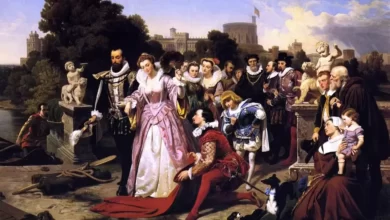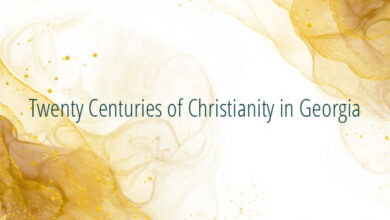
Prehistoric Georgia and Rise of Societies and States
Georgians are believed to derive from indigenous inhabitants of the Caucasus. Historical and archeological evidence indicates that humans inhabited this region since primordial times. The oldest traces of human habitation, dating back 1.77 million years, were found near Dmanisi, in eastern Georgia, and provided tantalizing insights into the development of homo erectus. In the later periods, humans settled in the Trancaucasian region more frequently and ancient stations were found throughout the country, notably at Yashtkhva, Rukhi, Katskhi and Lashebalta. During the Mousterian period (100,000 to 35,000 years ago), the human population grew on the Black Sea coast and in the Rioni-Kvirila basin, where archeologists found traces of human habitation in the Jruchi, Sagvarjile and Chakhati caves. Late Paleolithic period stations were unearthed at Devis Khvreli and Sakazhia, and the discoveries from the Neolithic era were made at Anaseuli, Gurianta, Khutsubani, Odishi, Kistriki, Zemo Alvani, etc.
Rise of Societies And States
Between ca. 11000 and 9000 BCE, hunters and gatherers established permanent settlements in Southern Caucasia. In the Chalcolithic period (ca. 6400–3800 BCE), Shulaveri-Shomu culture flourished using obsidian for tools, raising animals and growing crops, including grapes. The fourth and third millennia BCE saw gradual development of agriculture and cattle breeding. From ca. 4000 to 2200 BCE, the Kura-Araxes (Early Transcaucasian) culture pervaded Southern Caucasia and the Armenian Plateau, producing distinctive handmade pottery with burnished black exteriors and red interiors, portable andirons of clay and new kinds of bronze tools and weapons. It gradually broke up but survived in some places until as late as ca. 1500 BCE. In the Bronze Age, several highly developed cultures developed on the territory of Georgia that are represented in the large barrows in Trialeti (ca.2200-1500) which produced four-wheeled wooden carriages, precious goblets and silverware.
At the end of the third millennium, the Hittites established their state in eastern Anatolia and had considerable influence on the neighboring proto-Georgian tribes. Two major cultures existed on the territory of Georgia, the Western Georgian, also known as Colchian (Kolkhuri) and the Eastern Georgian or Iberian. There was also a number of proto-Georgian tribes in Asia Minor which had close interaction with major powers of the ancient Near East, especially with the Hittites and Assyria. Assyrian inscriptions from the 11th century BCE describe proto-Georgian tribes of Kashkai, Mushki and Tubal that lived in eastern Anatolia. Georgian tribes of the early Bronze Age were well known for their sophisticated metallurgy. The Bible makes mention of Thubals/Tubalcain as one of the pioneers in metalworking.
The increasing sophistication of these early Georgian cultures led to the emergence of the tribal confederations of Diauchi (Diauehi, Daiaeni, Tao) and Colchis (Kolkha) at the end of the second millennium BCE in southwestern and western Georgia respectively. Diaochi was engaged in a war with the powerful kingdoms of Assyria and Urartu and the inscriptions of the Urartu kings Menua (ruled 810-786 BCE) and Argishti (786-764) reveal the wealth and power of this early confederation. In his Odyssey, Homer mentions King Aietes and his mighty kingdom of Colchis while Apollonius of Rhodes, in his Argonautica of the third century BCE, left a detailed account of the legendary expedition of Argonauts to seize the famed Golden Fleece.
In the mid-eighth century BCE, the Diaochi confederation was destroyed and part of its territory was annexed by the neighboring Colchis, which now found itself facing the hostile Urartu. The Urartian King Sardur II (764-735) led several campaigns against Colchis around 750-741 BCE, significantly weakening and exposing it to the attacks of northern tribes. By 720 BCE, the Cimmerian incursions from the north destroyed Colchis and significantly affected local society and culture. Some Georgian tribes were scattered into remote regions of south Caucasia and others found themselves subjected by the Medes and Persians. In the subsequent century, new tribal confederations were established, the most important of them being Speri (Sasperi) in the upper reaches of the Chorokhi River and the new kingdom of Colchis, known as Egrisi, in Western Georgia. Egrisi enjoyed close relations with the newly established Greek colonies – Phasis (in the vicinity of present-day Poti), Gyenos (Ochamchire), Dioscurias (Sukhumi), Anakopia (Akhali Atoni) and Pitius (Bichvinta) – on the Black Sea coast and the Greek sources provide fascinating insights into ancient Western Georgian society. Excavations at Vani, Dablagomi and Sairkhe in western Georgia revealed a sophisticated and urbanized society which struck its own silver coins known as the Colchian white (kolkhuri tetri) that were widely circulated in the Transcaucasia.
By the seventh century BCE, the Georgian principalities were affected by the rise of powerful Median and later Persian kingdoms. Herodotus informs us that the proto-Georgian tribes of Tibarenes, Mossinikoi, Macrones, Moschi, and others made up the 18th and 19th satrapies of the Achaemenid Persia. While most Persian subjects paid taxes, Colchians were exempt from them but delivered a tribute of 200 girls and boys every five years. The Greek and Persian presence in the Transcaucasia exposed Georgian societies to thriving commerce, economic and commercial ties with other regions and considerably affected the socio-economic development of the region. The period saw the consolidation of Eastern Georgia (Iberia) and the migration of some Georgian tribes, the most important of them being Moschi/Meskhi from the Asia Minor, which settled in the central Kartli and founded the future Iberian capital of Mtskheta (city of Meskhi). By the time the famous Greek general Xenophon marched with his 10,000 soldiers through Asia Minor in 401-400 BCE, the Colchians and other proto-Georgian tribes had freed themselves from the Persians. Xenophon’s Anabasis described in detail the tribes of Chalybes, Taochi, Phasians, Mossynoeci and others the Greeks encountered. These proto-Georgians lived in communal societies and often warred with one another.
Historical Dictionary of Georgia
by Alexander Mikaberidze (Author)
Series: Historical Dictionaries of Europe (Book 50)
Hardcover: 784 pages
Publisher: Scarecrow Press (March 16, 2007)
Language: English
ISBN-13: 978-0810855809
ISBN-10: 0810855801




